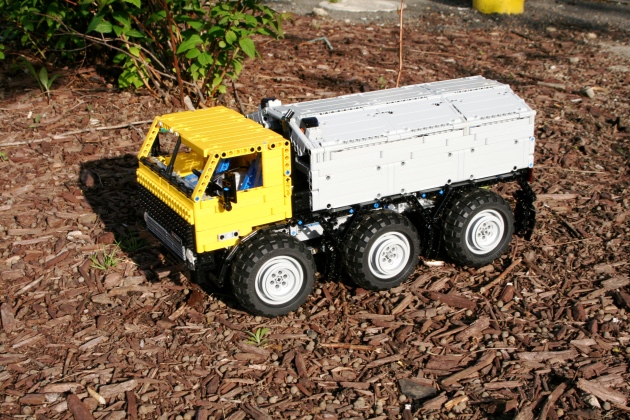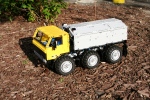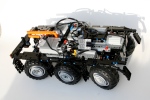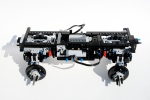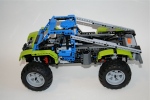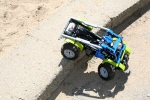Zil 132
May 4, 2012 4 Comments
A couple of months ago I was struck by a new design by Waler. It was refreshing to see a well made Trial Truck based on something a little different. I wanted to make a model of my own. Thanks to him for the inspiration, and for the great ideas on the cab and the fenders.
From the beginning I knew this truck was not going to be a serious off road contender, but I wanted to redesign the whole drivetrain. I decided to go with a pendular suspension for the first and second axle and a trailing live axle for the third axle. All three axles would have a differential and a a set of portal axles. The first and the third axle would also have steering linked together. As is often the case with my trucks, I had the pendular axles held by a turntable with the steering function passed through the turntable by use of a differential. The second axle was held by a turntable in the front, and the steering differential passed through to provide steering to the final axle. The drive function powered all three axles and would connect to the transmission and motor in between the first and second axle.
The third axle was a suspended live axle that had a trailing setup created with the new 8110 pieces. This would allow for rotational and vertical articulation while connecting the drive shaft and giving space to the steering function above. The steering shaft would allow for movement via a CV joint. The Power Functions M steering motor was placed in the rear, and used a simple 1:9 reduction.
A Power Functions XL was used for the drive funtion and was placed between the front two seats. The motor was mounted on a sliding assembly for the gearbox function, much like the design pioneered by ATRX. I used my three speed changeover design to move the motor through three gears, for a final ration of 1:7.5, 1:4.7, and 1:3. The gearshift worked perfectly. While the drivetrain was a little complicated, the gearing was rather simple. The battery boxes were place above the second axle side by side. This kept the weight centered, and as low as I could get it.
Finally I added a cabin and a cargo area. The cabin was straight from Waler’s design, as was much of the fender area. I used technic panels to create the cargo area, which also gave me a space to place the two IR receivers. This also hid the two battery boxes, and the wiring, and generally cleaned up the truck. I created two small doors in the top to assist with picking up the ZIL. I was done.
Over mostly level ground the ZIL was one of my better designs. The differentials and steering worked flawlessly to make the ZIL drive easily. The gearbox worked well and eased the drivetrain over slight irregularities. But once the pavement turned to dirt the ZIL struggled a little more. It was not designed to have too much suspension travel, and this showed. It struggled on some of the bigger bumps, as the tires would scrape the wheel-wells. Overall, I was pleased with the design, and was happy with the way it turned out. It looked great, it was fun to build, and it was a blast to drive.
The full gallery can be viewed here. Also, a big thank you to The Lego Car Blog for posting this model on their blog.

